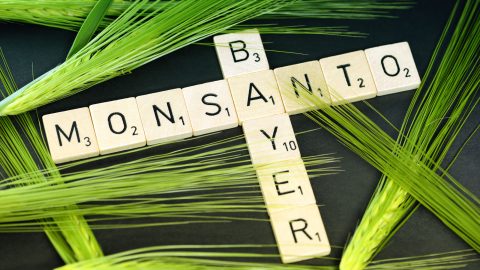Minus 69%. If the current loss of biodiversity were happening to share prices on the equity market, panic would probably set in because of the magnitude of that number. The reaction would be immediate aid packages from politicians, strategic adjustments to business models, the redirection of financial flows, and a wave of innovative diligence that took advantage of the changes in the long term. This is exactly what we need right away to protect biodiversity. For companies that act now, there are already both practical and economic solutions that pay for themselves many times over.
The biodiversity of our planet secures the foundations of life and the economy
Businesses need raw materials such as water and timber as well as business-enhancing ecosystem services such as pollination, water regulation, and soil fertility for their economic activities. According to current estimates, about USD 44 trillion in value-added depend moderately or heavily on nature and the services it provides. In everyday business, the existential dependence on intact ecosystems and their protection still receives little attention, despite threatening signs.
The facts of the status quo are alarming
According to a study by the World Biodiversity Council IPBES, 14 out of 18 ecosystem services examined are in decline as we speak, which translates into a negative trend of around 80%. Not only quality of life and health are at stake, but also prosperity and economic development.
The World Economic Forum’s Global Risks Report 2023 confirms that six of the ten greatest risks to the global economy over the next ten years are directly related to the environment. The loss of biodiversity and the collapse of the ecosystems are among the top five risks, up there with natural disasters and a failure to contain the climate crisis. In this context, the change of land-use, the overexploitation of resources, the climate crisis, pollution, and invasive species continue to exacerbate the biodiversity crisis. All of these direct drivers are based on economic activities. At the same time, the acute loss of biodiversity is increasingly putting pressure on business owners along their entire value chains.

The risks for the economy are enormous
If ecosystem services are only available to businesses to a limited extent, increased costs, resource scarcity, and supply bottlenecks will follow. At the same time, corporate misconduct through non-action or lack of transparency increasingly garners criticism from the public and leads to losses in brand value. The need to act in an entrepreneurial fashion is also driven by regulatory developments such as the CSRD, the EU Taxonomy and the supply chain act (CSDDD).
Financial institutions are also exposed to biodiversity-related risks through their investments, financing, and insurance business. Any loss of biodiversity (and thus reduction in nature’s ability to provide ecosystem services) has a negative financial impact on financial institutions, whether as insurance claims, investment losses, or loan defaults.
In order to stop the loss of biodiversity, even ambitious efforts in nature conservation are not sufficient. A real reversal of the trend calls for a simultaneous change in the way we invest, produce, and consume. This is the only way to bring about the urgently needed changes in the time that we still have. The real and financial economy have a central role to play in this – not only to minimise risks for one’s own business activities, but rather to prevent negative effects of one’s own economic actions. Those who analyse the resulting economic consequences, understand them, and establish measures based on them, ensure a key asset for the economic success of tomorrow.
Competitive advantage through the protection of biodiversity in the core business
The conservation, sustainable use, and restoration of biodiversity offers significant business opportunities, including cost savings and increases in operational efficiency. In addition, revenue streams may arise from new business models and access to new markets, products, and services. Likewise, in addition to preserving a future worth living, business owners benefit from improved stakeholder relations and a better corporate image. Also, due to regulatory measures such as CSRD, CSDDD, and the EU Taxonomy, companies will have to fulfil more and more reporting obligations in the future and disclose their impact on the basis of clear rules. Strategic biodiversity protection prepares companies for these requirements.
Minimising risks, seizing opportunities: practical solutions for businesses
Effective biodiversity strategies by companies are based on one fundamental principle: reducing the significant impact of corporate activities along the entire value chain. Dependencies and impacts are compared and prioritised. Corporate activities that are harmful to biodiversity are primarily avoided and, if there is no alternative, reduced as much as possible. This goes in tandem with measurable and time-bound targets based on the best available scientific knowledge.
What should businesses do now?
With the help of WWF Biodiversity Stewardship, businesses can integrate biodiversity into their holistic corporate strategy and measures and link it to existing climate protection strategies. The following steps are necessary:
- Risk assessment
Recording and assessment of opportunities and risks along the value chain in the form of a materiality analysis. The WWF Biodiversity Risk Filter provides a good insight. - Prioritisation of objectives
Central fields of action and locations are selected, with a link set up to the existing climate and sustainability strategy. Please use the information provided by the Science Based Targets for Nature Network. - Act & Track:
The previous step is followed by a systemic integration of measures along the value chain and beyond. Internal capacities are also being built for this purpose. The progress must be regularly evaluated and assessed. - Advocacy & creation of awareness
The above steps are accompanied by investments in reconstruction and regeneration measures, the creation of awareness among stakeholders, targeted public advocacy, and networking with regional actors and interest groups.
More information, insights and expert opinions on the topic of biodiversity can be found in our new ESGenius Letter.
For a glossary of technical terms, please visit this link: Fund Glossary | Erste Asset Management
Legal note:
Prognoses are no reliable indicator for future performance.
Legal disclaimer
This document is an advertisement. Unless indicated otherwise, source: Erste Asset Management GmbH. The language of communication of the sales offices is German and the languages of communication of the Management Company also include English.
The prospectus for UCITS funds (including any amendments) is prepared and published in accordance with the provisions of the InvFG 2011 as amended. Information for Investors pursuant to § 21 AIFMG is prepared for the alternative investment funds (AIF) administered by Erste Asset Management GmbH pursuant to the provisions of the AIFMG in conjunction with the InvFG 2011.
The currently valid versions of the prospectus, the Information for Investors pursuant to § 21 AIFMG, and the key information document can be found on the website www.erste-am.com under “Mandatory publications” and can be obtained free of charge by interested investors at the offices of the Management Company and at the offices of the depositary bank. The exact date of the most recent publication of the prospectus, the languages in which the key information document is available, and any other locations where the documents can be obtained are indicated on the website www.erste-am.com. A summary of the investor rights is available in German and English on the website www.erste-am.com/investor-rights and can also be obtained from the Management Company.
The Management Company can decide to suspend the provisions it has taken for the sale of unit certificates in other countries in accordance with the regulatory requirements.
Note: You are about to purchase a product that may be difficult to understand. We recommend that you read the indicated fund documents before making an investment decision. In addition to the locations listed above, you can obtain these documents free of charge at the offices of the referring Sparkassen bank and the offices of Erste Bank der oesterreichischen Sparkassen AG. You can also access these documents electronically at www.erste-am.com.
N.B.: The performance scenarios listed in the key information document are based on a calculation method that is specified in an EU regulation. The future market development cannot be accurately predicted. The depicted performance scenarios merely present potential earnings, but are based on the earnings in the recent past. The actual earnings may be lower than indicated. Our analyses and conclusions are general in nature and do not take into account the individual characteristics of our investors in terms of earnings, taxation, experience and knowledge, investment objective, financial position, capacity for loss, and risk tolerance.
Please note: Past performance is not a reliable indicator of the future performance of a fund. Investments in securities entail risks in addition to the opportunities presented here. The value of units and their earnings can rise and fall. Changes in exchange rates can also have a positive or negative effect on the value of an investment. For this reason, you may receive less than your originally invested amount when you redeem your units. Persons who are interested in purchasing units in investment funds are advised to read the current fund prospectus(es) and the Information for Investors pursuant to § 21 AIFMG, especially the risk notices they contain, before making an investment decision. If the fund currency is different than the investor’s home currency, changes in the relevant exchange rate can positively or negatively influence the value of the investment and the amount of the costs associated with the fund in the home currency.
We are not permitted to directly or indirectly offer, sell, transfer, or deliver this financial product to natural or legal persons whose place of residence or domicile is located in a country where this is legally prohibited. In this case, we may not provide any product information, either.
Please consult the corresponding information in the fund prospectus and the Information for Investors pursuant to § 21 AIFMG for restrictions on the sale of the fund to American or Russian citizens.
It is expressly noted that this communication does not provide any investment recommendations, but only expresses our current market assessment. Thus, this communication is not a substitute for investment advice, does not take into account the legal regulations aimed at promoting the independence of financial analyses, and is not subject to a prohibition on trading following the distribution of financial analyses.
This document does not represent a sales activity of the Management Company and therefore may not be construed as an offer for the purchase or sale of financial or investment instruments.
Erste Asset Management GmbH is affiliated with the referring Sparkassen banks and Erste Bank.
Please also read the “Information about us and our securities services” published by your bank.
Subject to misprints and errors.



